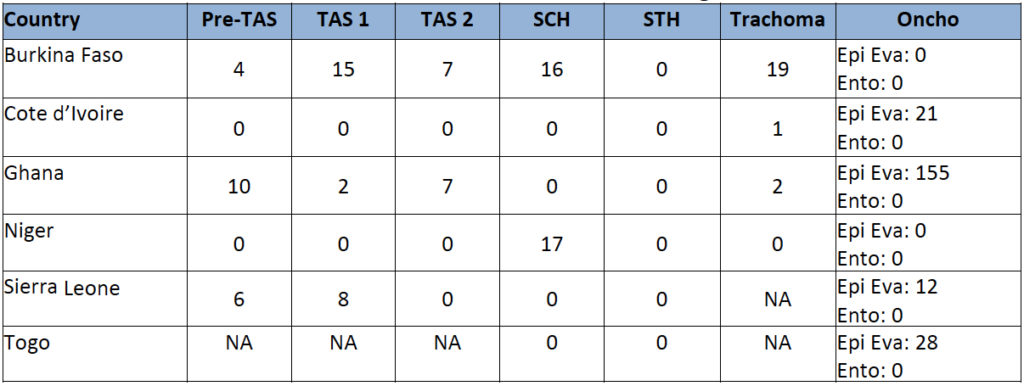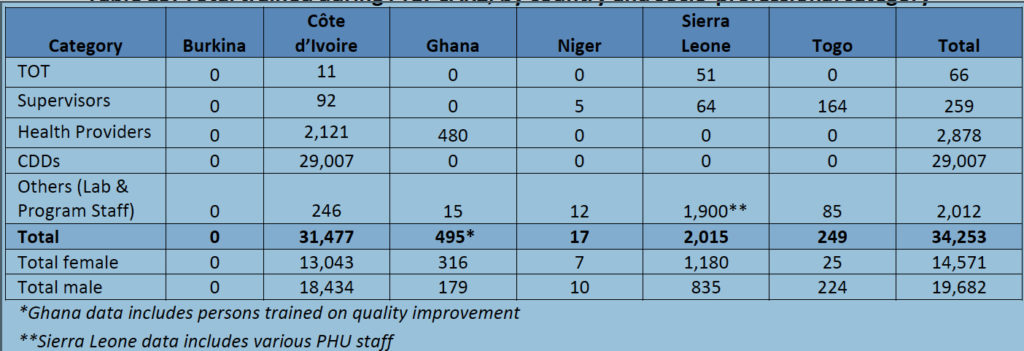Mass Drug Administration and Disease Assessment
Mass Drug Administration
In FY 2017, 19,032,983 people were treated for at least one NTD and 34,535,401 treatments were provided. However, these numbers are expected to increase, as Ghana, Niger, and Sierra Leone planned their MDAs in the last quarter of FY17, hence their respective vetted results are still pending.
In the second half of FY 2017:
- Burkina Faso: conducted 3 mass drug administrations (MDAs): schistosomiasis (SCH) MDA in 5 regions, which achieved a program coverage of 97.95%. The Sud-Ouest region implemented its second round of lymphatic filariasis (LF) and onchocerciasis (oncho) treatment for FY 2017 in four health districts (HDs) for each disease, and preliminary results show program coverage of 81.41% and 80.26%, respectively. Centre-Est region conducted the second round of SCH MDA, but results are not yet available.
- Cote d’Ivoire: conducted 3 MDAs with USAID funding: LF/oncho MDA in 57 HDs with an overall program and therapeutic coverage of 89.79% and 71.83%, respectively. Because LF MDA is also treatment for STH for individuals ≥ 5 years, the STH results for the 22 STH-endemic HDs, which were among the 57 HDs treated for LF/oncho, show a therapeutic coverage of 71.26% and program coverage of 90.24%. END in Africa supported SCH treatment of adults (≥ 15 years) in the 3 HDs with a baseline SCH prevalence of ≥ 50% and obtained a therapeutic coverage of 83.62%. The trachoma MDA conducted in 5 HDs achieved a therapeutic coverage of 93.97%.
- Ghana: due to a nation-wide oncho impact assessment, all MDAs were delayed to allow for the required time to elapse between the last MDA and the impact assessment. Results for the community-based LF/oncho/STH MDA and the community-based treatment for SCH in adults conducted simultaneously with the school-based MDA will be available in the next reporting period.
- Niger: conducted its second FY 2017 MDA campaign in 4 regions. Preliminary results are available for Agadez region and show the region achieved program coverage of 86.1% and 86.5% for LF and trachoma, respectively.
- Sierra Leone: conducted SCH MDA in 7 HDs, with NTDP-reported program coverage of 80.5% and independent monitoring-reported program coverage of 60%. Falling disease burden and overlap with malaria bed net distribution, mother and child health week, and the Muslim month of Ramadan, all of which coincided with the MDA, contributed to the low program coverage rate. Additional MDAs were conducted for LF/STH in the Western Area (WA), LF/oncho/STH in 4 HDs, and Oncho/STH in 8 HDs, but treatment data is not yet available.
- Togo: Conducted nationwide integrated MDA to treat STH, SCH, and oncho in August 2017. Data collection, entry, cleaning, and analysis are planned and coverage numbers and final reports are expected in the next semi-annual report.
Notes: TOT: training of trainers; CDDs: community drug distributors; PHU: peripheral health unit
Disease-Specific Assessments
In order to measure the impact of MDA on disease prevalence, the NTD Control Program supports disease-specific assessments at defined intervals in line with WHO guidelines. The status of disease-specific assessments is depicted by countries in the tables below:
Assessments conducted in April – September 2017

Notes: Oncho: onchocerciasis; SCH: schistosomiasis; STH: soil-transmitted helminthiasis; TAS: transmission assessment survey; Epi Eva: Epidemiological evaluation; Ento: entological

Photo Credit: neglecteddiseases.gov



